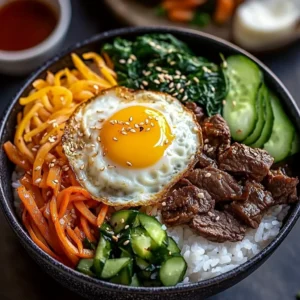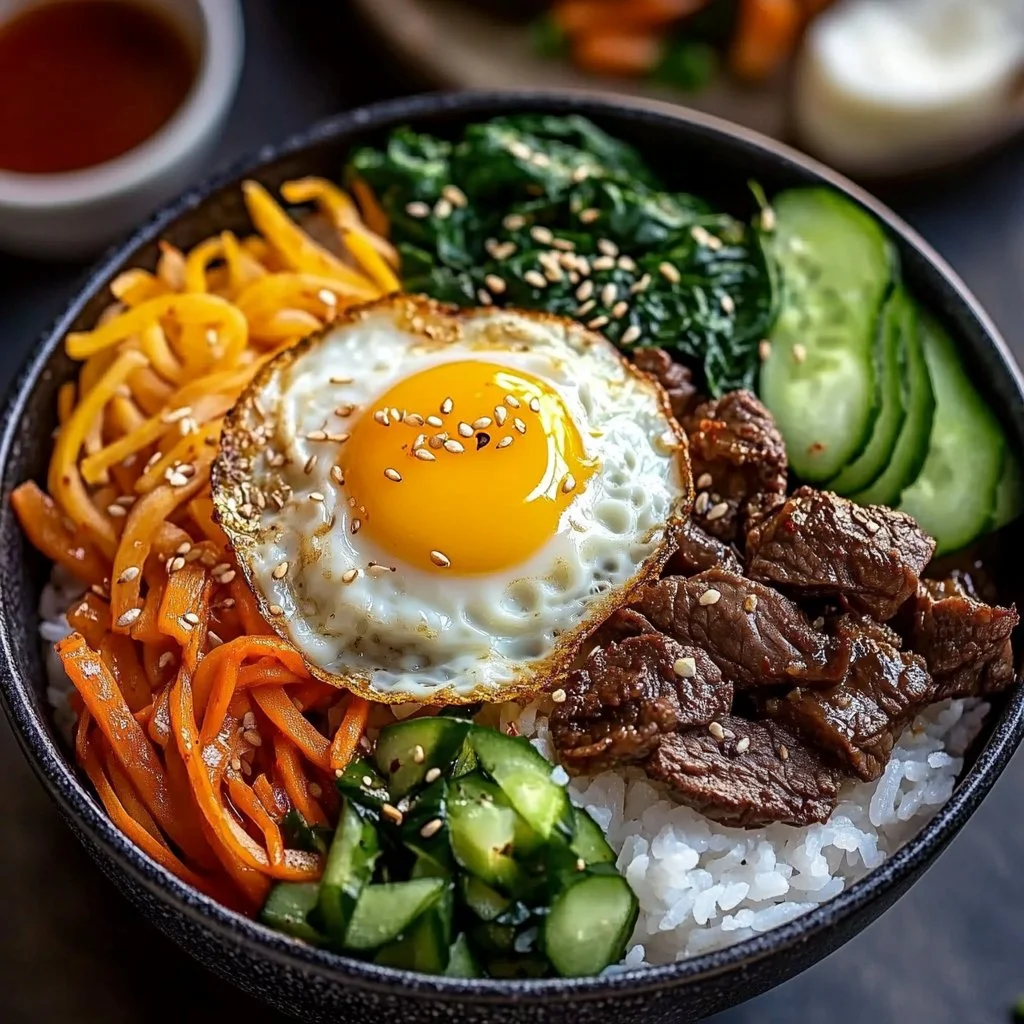This post may contain affiliate links. As an Amazon Associate, I earn from qualifying purchases at no extra cost to you.
Table of Contents
Are you looking for a delicious and colorful dish that packs a punch of flavor? Look no further than Easy Korean Bibimbap! This classic Korean dish, which translates to “mixed rice,” is a feast for the eyes and a delight for your taste buds. Each bowl is a vibrant array of sautéed vegetables, marinated beef, a runny fried egg, and a dollop of spicy gochujang sauce, all layered over perfectly cooked rice.
With Easy Korean Bibimbap, you can enjoy a wholesome meal that’s not just satisfying but also incredibly fun to eat! Imagine sitting down to a bowl filled with fresh veggies and flavorful beef, topped with a bright egg. Does it get any better? Cooking at home can sometimes feel overwhelming, but this recipe is simple enough for even beginner cooks. Are you ready to dive in and discover how to create Easy Korean Bibimbap right in your kitchen?
🍴 Top Kitchen Essentials You'll Love
Key Benefits of Easy Korean Bibimbap
Why You’ll Love This Recipe
- Nutrient-Rich Ingredients: Easy Korean Bibimbap is packed with a variety of vegetables, which add fiber, vitamins, and minerals. By including leafy greens like spinach or other colorful veggies, you’re not just eating delicious food, but you’re also nourishing your body. Each component of this dish contributes to a balanced meal.
- Customizable to Your Taste: One of the best aspects of Easy Korean Bibimbap is its versatility. You can choose the vegetables according to your preference or seasonal availability. Not a fan of beef? Swap it out for chicken, tofu, or even chickpeas. This adaptability makes it enjoyable for everyone.
- Wholesome Comfort Food: There’s something comforting about a warm bowl of rice topped with all kinds of tasty toppings. Easy Korean Bibimbap is perfect for a cozy dinner at home or a gathering with friends. It evokes warmth and togetherness, making every meal a bit more special.
- Quick and Simple Preparation: Don’t have much time to cook? No problem! Easy Korean Bibimbap comes together in less than 30 minutes. With a little prep work and a few ingredients, you’ll have a satisfying meal ready to enjoy without hours in the kitchen.
- Fun to Make and Eat: This dish is as enjoyable to prepare as it is to savor. Each ingredient can be prepped individually, which makes it a fun cooking experience. And when it’s time to eat, you get to mix everything together and create your own unique bite with every scoop.
- Perfect for Meal Prep: If you’re someone who loves to meal prep, Easy Korean Bibimbap is an excellent option. You can prepare the components in advance and mix them together when you’re ready to eat. That way, you’ll always have a delicious meal on hand without the hassle of daily cooking.
What Makes It Stand Out
What truly makes Easy Korean Bibimbap unique is its beautiful visual appeal and flavor profile. The combination of ingredients brings a delightful crunch, tenderness, and a rich umami flavor that dances on your palate. Each layer serves a purpose, not just for flavor but also for texture. The crispy vegetables contrast wonderfully with the tender beef and the runny egg yolk, creating a satisfying eating experience.
Furthermore, Easy Korean Bibimbap offers a perfect blend of healthy and indulgent. You feel good while eating it, yet it’s also incredibly satisfying with the savory beef and spicy gochujang sauce. The balance of healthiness and comfort makes it an ideal dish for any occasion, from a casual family dinner to a more festive gathering. You can also easily adjust the dish to fit any dietary needs, making it an all-around winner for diverse palates.
Ingredients for Easy Korean Bibimbap
Complete Ingredient List with Measurements
To create your own Easy Korean Bibimbap, you’ll need:
- 2 cups cooked white rice: Ideally, use short-grain rice for the authentic texture.
- 1 cup sautéed vegetables: Common choices are spinach, carrots, zucchini, and bean sprouts. Feel free to mix and match for variety.
- 1 cup marinated beef: Using bulgogi or similar marinated beef adds depth of flavor.
- 2 eggs: Fried sunny-side-up or over-easy; this is a key part of the dish.
- 3 tablespoons gochujang sauce: This fermented chili paste gives the dish its signature spice.
- Sesame oil: A small drizzle enhances the fragrance and flavor.
- Sesame seeds: For garnish and a slight crunch.
- Green onions: Chopped for an extra flavor boost and color.
Substitutes and Alternatives
If you have specific dietary needs or preferences, don’t worry; Easy Korean Bibimbap is versatile! Here are some helpful substitutes:
- Rice: If you’re looking for a healthier option, swap white rice for brown rice, quinoa, or cauliflower rice. These alternatives still provide a great base while adding more nutrients.
- Beef: If you’re avoiding red meat or going completely meat-free, opt for tofu, grilled chicken, or even tempeh. For a vegetarian twist, use mushrooms, which add a savory flavor.
- Vegetables: Customize the vegetables based on your liking or what’s in season. Bell peppers, radishes, or even broccoli can work well. If you have allergies, simply skip any ingredient you can’t consume and replace it with something suitable.
- Gochujang: For a milder heat, you can use sriracha or a mild chili paste. To make it gluten-free, check that your gochujang is gluten-free, or create a homemade version using chili powder, soy sauce, and a sweetener.
- Eggs: If you’re vegan, you can replace the eggs with scrambled tofu, which offers a similar texture.
No matter your dietary needs, Easy Korean Bibimbap can be tailored to how you like it!
How to Make Easy Korean Bibimbap – Step-by-Step Directions
Step 1 – Prepare Your Workspace and Ingredients
Start by gathering all your ingredients. Having everything you need within reach will streamline the cooking process. Cook your rice according to package instructions, usually around 20 minutes for white rice. While the rice cooks, you can prep your vegetables and beef. Wash and cut the vegetables into thin strips or bite-sized pieces for even cooking. If you’ve chosen to use marinated beef, make sure it’s ready for cooking. Clean your workspace and lay out any utensils you’ll need, like frying pans, spatulas, and bowls. This makes everything flow smoothly when you’re ready to cook.
Step 2 – Sauté the Vegetables
Next, heat a pan over medium heat and add a splash of oil. Once the oil is hot, toss in your prepared vegetables. You can start with denser veggies like carrots and zucchini and add lighter greens like spinach afterward. Stir-fry the vegetables for about 5-7 minutes or until they’re tender yet still have a slight crunch. The goal is to create bright, colorful vegetables that retain their nutrients.
Step 3 – Cook the Marinated Beef
In a separate pan, heat a bit of oil and add your marinated beef. Cook the beef over medium-high heat until it’s fully cooked and slightly caramelized, usually about 5-10 minutes. Be sure to stir occasionally to cook evenly. This step not only enhances the beef’s flavor but also adds a lovely richness to the dish. Once done, remove from heat and set aside.
Step 4 – Fry the Eggs
In a non-stick pan, fry the eggs to your liking. For traditional presentation, sunny-side-up is a favorite choice. Cook them gently so the yolks remain runny, allowing them to mix beautifully with the other ingredients when served. If you prefer your yolks cooked through, feel free to flip them for a more solid result.
Step 5 – Assemble the Bibimbap Bowl
Now comes the fun part—assembling your Easy Korean Bibimbap! In a bowl, start with a generous base of warm cooked rice. This warm base ensures that your ingredients stay cozy. Next, artfully arrange your sautéed vegetables and cooked beef on top of the rice. Finally, place the fried egg directly in the center, letting it nestle into the bowl.
Step 6 – Add Gochujang and Sesame Oil
Once your bowl is beautifully arranged, drizzle sesame oil over the top. Then, add gochujang sauce according to your heat preference. If you enjoy spicy food, go for a hearty dollop! You can always add more later, so start with a smaller amount if unsure.
Step 7 – Garnish Your Dish
To take your Easy Korean Bibimbap to the next level, don’t forget the garnishes! Sprinkle sesame seeds over the top and add some chopped green onions for a fresh kick. These tiny details elevate the presentation and make your bowl even more mouthwatering.
Step 8 – Mix It Up Before Eating
Before diving in, give your bibimbap a good mix. Incorporating all the layers ensures that every bite is bursting with flavor. The rice, veggies, beef, and egg, along with the gochujang sauce, create a symphony of tastes and textures. Now it’s time to enjoy your homemade Easy Korean Bibimbap to its fullest!
Serving Suggestions for Easy Korean Bibimbap
Best Occasions to Serve This Dish
Easy Korean Bibimbap is perfect for various occasions. Whether it’s a casual weeknight dinner, meal prep for your workweek, or a fun get-together with friends, it fits snugly into any setting. The vibrant colors and diverse flavors make it impressive enough for entertaining guests. You can also make it a fun cooking night where everyone customizes their own bowl! Sharing this experience around a dining table can turn an ordinary meal into a memorable one.
What to Serve With It
To enhance your dining experience, consider pairing Easy Korean Bibimbap with side dishes. Kimchi, a staple in Korean cuisine, provides a spicy and tangy complement that balances the meal. You might also enjoy a simple cucumber salad, which adds a refreshing crunch. As for beverages, iced green tea is a popular choice, as it cleanses the palate without overpowering the dish.
How to Store Easy Korean Bibimbap Properly
Best Storage Practices
If you’ve made a big batch of Easy Korean Bibimbap and want to store leftovers, you’re in luck! Begin by letting everything cool to room temperature. Place the components separately in airtight containers to preserve freshness. Store your cooked rice, sautéed vegetables, and cooked beef in one container, and store the egg and garnishes separately. In this way, the textures remain intact. Typically, you can refrigerate them for up to 3-4 days.
Reheating and Freezing Tips
When you are ready to enjoy your leftovers, you can reheat portions in the microwave or on the stovetop. If using the microwave, cover the bowl to keep moisture. For stovetop reheating, add a bit of water with the rice to prevent it from drying out. If you want to freeze your Easy Korean Bibimbap, do so without the fried egg and garnishes. Most components freeze well for about 2-3 months, but be aware that texture can change slightly upon reheating.
Tips & Tricks for Easy Korean Bibimbap
Mistakes to Avoid
- Overcooking Vegetables: Be mindful of cooking time to retain the crunch and nutrients.
- Using Cold Rice: Always use warm rice; this enhances flavor and helps blend ingredients better.
- Too Much Gochujang: Start small; it’s easier to add more spice than to tone it down!
- Skipping Garnish: Don’t underestimate the impact of garnishes like sesame seeds and green onions; they add flavor and beauty.
- Forgetting the Mixing: A big part of the joy in bibimbap is mixing everything together before eating!
- Ignoring Texture Variety: Balance crunchy and soft ingredients for a more enjoyable bite.
Extra Tips for Better Results
To truly elevate your Easy Korean Bibimbap, consider these helpful tips. Experiment with different marinades for your beef; adding pear or apple juice not only sweetens the beef but also helps tenderize it. Try using various cooking methods such as grilling the ingredients for a smoky flavor. Using a cast-iron skillet for frying your egg can add a delightful crispy edge. Lastly, don’t shy away from trying exotic toppings like nori strips or pickled radishes! They can introduce new flavors and excitement to your bowl.
Recipe Variations of Easy Korean Bibimbap
Creative Twists
- Korean Taco Bibimbap: For a fusion twist, serve Easy Korean Bibimbap fillings in corn or flour tortillas. Tuck the fillings in and top with fresh cilantro and a squeeze of lime for a refreshing flavor.
- Spicy Seafood Bibimbap: Swap out the beef for sautéed shrimp or a mix of seafood. A touch of chili oil can add extra heat and flavor, creating a beachy vibe.
- Bibimbap Burrito Bowl: Integrate a variety of beans for protein, and serve over rice with salsa and avocado. Wrap it all in a flour tortilla for an easy-to-eat burrito version of Bibimbap!
- Grain-Free Bibimbap: For a low-carb option, use spiralized vegetables instead of rice. Zucchini or carrot noodles can create a nutrient-packed base for your toppings.
Dietary Adjustments
If you want to make Easy Korean Bibimbap more accessible for special diets, here are some ideas. To cater to vegans, replace meat with marinated tofu and use nutritional yeast to enhance the cheesy flavor. For gluten-free needs, make sure your gochujang is gluten-free and substitute soy sauce with tamari. To create a dairy-free version, simply eliminate any dairy ingredients and stick to plant-based sauces. Adapting this recipe makes it inclusive for everyone at the table.
Conclusion about Easy Korean Bibimbap
In closing, Easy Korean Bibimbap is not merely a recipe; it’s an experience filled with vibrant flavors, colors, and textures. It invites you to customize and create your own culinary masterpiece, making it a fun meal for anyone, from seasoned cooks to kitchen novices. With its quick preparation time, health benefits, and incredible flavors, it truly stands out. So why not gather your ingredients and give it a try? You’ll soon discover why Easy Korean Bibimbap is a beloved dish worldwide. Get inspired, experiment, and share this delightful recipe with friends and family!
FAQs about Easy Korean Bibimbap
What if it doesn’t turn out right?
If your Easy Korean Bibimbap doesn’t turn out as expected, don’t worry! Evaluate each component, such as the rice texture or vegetable crunch. If the rice is too sticky, add a dash of water when reheating for the next meal. Should the vegetables have become too soft, consider reducing cooking time on your next attempt.
Can I make it ahead of time?
Yes! You can prepare components of Easy Korean Bibimbap ahead of time. Cook the rice, sauté vegetables, and even the beef can be stored separately in the fridge. Assemble everything just before serving for the best results.
Can I freeze it?
Certainly! You can freeze the cooked vegetables, rice, and meat components of Easy Korean Bibimbap. Just ensure the egg and garnishes are added fresh when ready to serve.
How long does it stay fresh?
When stored properly in airtight containers, Easy Korean Bibimbap can last around 3-4 days in the refrigerator. For items in the freezer, aim to consume them within 2-3 months for optimal freshness.
What can I serve it with?
You can serve Easy Korean Bibimbap with a side of kimchi or a light salad. Additionally, beverages like iced green tea or a light beer complement the flavors beautifully.
Is Easy Korean Bibimbap healthy?
Yes! Easy Korean Bibimbap is healthy, offering a balanced meal with proteins, vegetables, and grains. You can further enhance its nutritional value by adding more veggies or using whole grains.
Can I adjust the spice level?
Absolutely! You can adjust the spice level by varying the amount of gochujang or substituting with a milder sauce like sriracha or sweet chili sauce.
What rice is best for Bibimbap?
Short-grain white rice is traditionally used for Easy Korean Bibimbap. However, brown rice or cauliflower rice can also serve as healthy alternatives!
Can I omit the egg?
Definitely! If you don’t consume eggs or prefer to skip them, simply leave them out or replace them with scrambled tofu for a similar texture.
Is Easy Korean Bibimbap suitable for kids?
Yes, Easy Korean Bibimbap is generally kid-friendly. Its vibrant appearance and customizable ingredients may entice children. Plus, you can control the level of spiciness based on their preferences!

Korean Bibimbap
Equipment
- Large skillet or wok
- Rice cooker or pot
- Mixing Bowls
Ingredients
Rice
- 3 cups cooked short-grain rice warm
Beef Marinade
- 8 oz beef sirloin thinly sliced
- 1 Tbsp soy sauce
- 1 tsp sugar
- 1 tsp sesame oil
- 1 clove garlic minced
Vegetable Toppings
- 1 cup bean sprouts blanched
- 1 cup spinach blanched and seasoned with sesame oil and salt
- 1 carrot julienned and lightly sautéed
- ½ zucchini julienned and sautéed
- 4 shiitake mushrooms sliced and sautéed
- 1 cucumber julienned (optional)
Other Toppings
- 4 fried eggs sunny side up
- 1 Tbsp sesame seeds for garnish
Gochujang Sauce
- 3 Tbsp gochujang (Korean red chili paste)
- 1 Tbsp sesame oil
- 1 Tbsp water
- 1 tsp sugar
- 1 tsp rice vinegar
Instructions
- In a bowl, mix soy sauce, sugar, sesame oil, and garlic. Add sliced beef and marinate for 15 minutes.
- In a skillet over medium-high heat, cook the marinated beef until browned and cooked through. Set aside.
- Prepare each vegetable separately by blanching or sautéing lightly with salt and a touch of sesame oil. Set aside in individual bowls.
- Mix gochujang sauce ingredients in a small bowl until smooth and set aside.
- To assemble, place a portion of rice into each bowl. Arrange beef and vegetables neatly on top.
- Top each bowl with a fried egg and sprinkle with sesame seeds. Serve with gochujang sauce on the side.
- To eat, mix everything together thoroughly with the sauce before enjoying.
 🖤 BLACK FRIDAY SALE: Get the Christmas Cookbook for only
🖤 BLACK FRIDAY SALE: Get the Christmas Cookbook for only 




